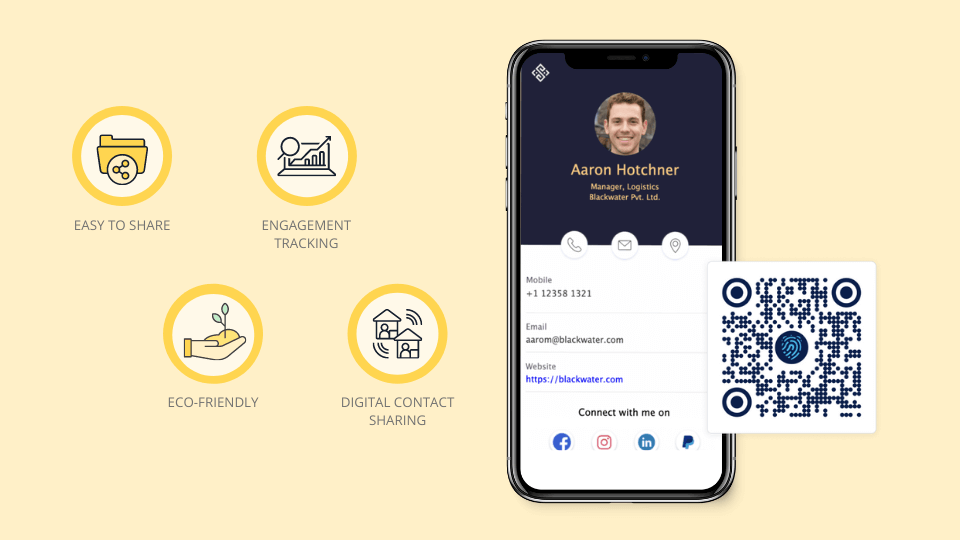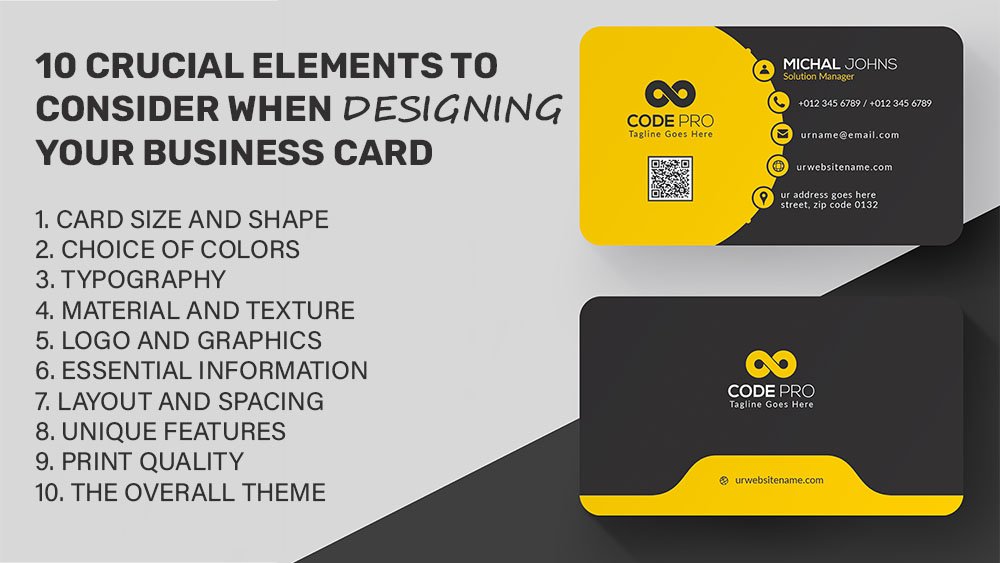Introduction
In today’s digitally driven world, the way we exchange contact information is evolving, leading to the traditional versus digital business cards debate. With both types offering distinct advantages and disadvantages, understanding the nuances can guide you to make an informed decision. This article compares these two business card formats to help you decide which is the best fit for your professional needs.
Part 1: The Evolution of Business Cards
1.1 The History of Traditional Business Cards
The use of business cards dates back to the 17th century in Europe, where they began their journey as trade cards. These cards served as advertisements and provided a map to merchants’ stores. By the 19th century, with the industrial revolution and the rise of the middle class, trade cards morphed into visiting cards, used primarily for social purposes.
In the 20th century, visiting cards evolved further into business cards, transitioning from a social tool to a business necessity. These traditional business cards were printed on high-quality cardstock and contained essential professional details. They served as a symbol of professionalism and legitimacy, setting a solid first impression during business interactions.
Despite the arrival of digital alternatives, traditional business cards remain relevant in today’s professional landscape, bridging the gap between the physical and the digital worlds.
1.2 The Emergence of Digital Business Cards
The early 2000s marked the onset of digital business cards, riding the wave of the internet boom. Their emergence was a response to a growing need for sustainable, economical, and versatile business networking tools.
1.2.1 Early Digital Business Cards
The first digital business cards were simple digital files, such as vCards, which could be attached to emails. While convenient and cost-effective, they lacked the visual appeal and the tactile connection that traditional business cards offered.
1.2.2 Modern Digital Business Cards
Modern digital business cards have come a long way from their early predecessors. Today, they’re interactive, customizable, and can be shared via email, text, or social media. From digital visiting cards to NFC digital business cards, and QR code-embedded cards, digital business cards are revolutionizing the way we network in the digital age.
The emergence of digital business cards represents a paradigm shift in business communication, integrating seamlessly with digital tools and platforms. They have been embraced as an eco-friendly alternative to their paper counterparts, aligning with the global drive towards sustainability.
1.2.3 Digital Business Cards Today
Today, digital business cards are not just about sharing contact information; they’re about building brands. They can include logos, color schemes, and multimedia elements, making them an extension of your company’s brand identity. This shift has been made possible due to advancements in design tools and the widespread accessibility of smartphones and the internet.
In summary, the evolution of business cards is a testament to changing times and technologies. From their beginnings as trade cards to the modern-day digital versions, business cards have continually adapted, offering new ways for professionals to connect and network.
Part 2: Understanding Different Types of Business Cards
2.1 What are Traditional Business Cards?
Traditional business cards are physical objects often crafted from premium cardstock or other durable materials. They usually carry crucial professional details such as the individual’s name, job title, company name, contact information (telephone number, email address), and often, the company logo.
2.1.1 Design and Layout of Traditional Business Cards
The design and layout of a traditional business card are usually kept minimal and professional. However, they can be customized to reflect the brand’s aesthetics, with some choosing bold colors and unique shapes to stand out.
2.1.2 Usability of Traditional Business Cards
Despite the rise of digital alternatives, traditional business cards remain a staple networking tool, especially in face-to-face interactions. Their tangibility creates a personal connection, often making the first impression a lasting one.
2.2 Understanding Digital Business Cards
Digital business cards are the virtual counterparts of traditional cards. They carry similar information but exist in an electronic format, which makes them easy to share, update, and store.

Digital Business Cards
2.2.1 Digital Visiting Cards
Just like traditional cards, digital visiting cards contain all your professional details. However, the digital format allows you to add much more: website links, social media handles, and even multimedia content such as videos or presentations. They can be shared through emails, social platforms, or messaging apps, making them highly versatile.
2.2.2 NFC Digital Business Cards
NFC digital business cards take the concept of digital cards to the next level. By integrating Near Field Communication (NFC) technology, these cards allow users to share their contact details just by tapping their card against a compatible device. This instantaneous sharing feature ensures a smooth and efficient networking experience.
2.2.3 Digital Business Card with QR Code
Digital business cards with QR codes incorporate a Quick Response (QR) code, which when scanned, directs the viewer to a digital platform, such as a website or a social media profile. This approach offers the advantage of providing more in-depth information about the individual or the company.
2.2.4 The Future of Digital Business Cards
With the rapid advancements in technology and an ever-increasing focus on sustainability, digital business cards are expected to become even more prevalent in the future. They represent an evolution in networking tools that aligns with the current digital transformation trends. The future might witness more innovative features, such as AR/VR integrations or advanced interactive elements, redefining the way we think about business cards.
In a nutshell, both traditional and digital business cards have their unique features and uses. While traditional cards appeal to the tactile and personal aspects of networking, digital cards leverage technology to offer versatility and convenience.
Part 3: The Pros and Cons of Traditional and Digital Business Cards
3.1 The Advantages of Traditional Business Cards
Traditional business cards have a long history of success in the professional realm and for good reasons.
3.1.1 Tangible and Personal
Traditional business cards are physical objects that can be held, resulting in a tactile and personal exchange. This tangible nature often leads to a stronger memory of the interaction and can help establish a deeper connection.
3.1.2 Universally Accepted
Regardless of technological preferences or capabilities, a traditional business card is universally understood and accepted. There is no requirement for a particular app, device, or even internet connectivity.
3.1.3 Easy to Distribute
Whether at conferences, meetings, or casual encounters, traditional business cards are easy to distribute and require no prior setup, making them a convenient networking tool.

Business card Distribution
3.2 The Drawbacks of Traditional Business Cards
While traditional business cards offer several benefits, they also come with some downsides.
3.2.1 Environmentally Unfriendly
The production and disposal of traditional business cards contribute to environmental degradation, an important consideration in today’s eco-conscious world.
3.2.2 Lack of Flexibility
Once printed, the information on a traditional business card cannot be changed. This lack of flexibility can lead to wasted cards if there are changes in your professional details.
3.2.3 Easy to Lose or Misplace
Due to their small size, traditional business cards can easily be lost or misplaced, which can potentially result in missed networking opportunities.
3.3 The Benefits of Digital Business Cards
Digital business cards offer several advantages that align well with today’s digital age.
3.3.1 Easy to Update and Share
Digital business cards can be updated quickly, ensuring your professional information is always accurate. They are also easy to share electronically, allowing for limitless distribution.
3.3.2 Eco-Friendly
Being virtual, digital business cards are a green alternative to traditional cards. They generate no physical waste, aligning with sustainable business practices.

Eco-friendly
3.3.3 Interactive and Informative
Digital cards can host multimedia content, links to websites, social media profiles, and much more, providing a comprehensive view of your professional persona or brand.
3.4 The Downfalls of Digital Business Cards
Despite their benefits, digital business cards also come with their challenges.
3.4.1 Technological Constraints
The effectiveness of a digital business card depends on the recipient’s technological proficiency and access to appropriate devices and internet connectivity. This can potentially limit their usage in certain contexts.
3.4.2 Lack of Personal Touch
The absence of a physical exchange may make digital cards feel impersonal to some, who prefer the tangible interaction that traditional cards offer.
3.4.3 Security Concerns
Like anything digital, these cards might be targets for cyber threats, causing some apprehension among security-conscious users.
By understanding the pros and cons of both types of business cards, you can make an informed choice that best aligns with your networking needs and preferences.
Part 4: How to Choose the Right Business Card for You
Deciding between a traditional business card and a digital one might seem challenging, but the decision becomes simpler when you consider your personal preferences, professional needs, and the nature of your audience.

Choose the Right Business Card
4.1 Know Your Audience
The choice of a business card often depends on the people you frequently interact with. If your target audience is tech-savvy and environmentally conscious, a digital business card may be a better fit. Conversely, if you’re in an industry where face-to-face meetings and personal touch are valued, traditional business cards may serve you better.
4.2 Consider Your Professional Needs
Your professional needs and the nature of your work also play a significant role in your choice of a business card. For instance, if you often attend international conferences or frequently travel for work, having a digital business card can simplify the process of sharing contact information. On the other hand, if you work in a creative industry, a well-designed traditional business card can be a mini-portfolio showcasing your design skills.
4.3 Think About Sustainability
In an increasingly eco-conscious world, choosing a digital business card aligns with sustainability and reduces paper waste. However, if you prefer traditional cards, consider using recycled materials or partnering with a print company committed to eco-friendly practices.
4.4 Evaluate the Cost
While traditional business cards involve an upfront cost for design and printing, digital business cards often come with a subscription fee for premium features. Evaluate your budget and decide which option offers the best value for your needs.
4.5 Look at the Flexibility
Digital business cards offer flexibility in terms of design and content updates. If your job role or contact information changes frequently, having a digital business card can save you from continually reprinting cards.
4.6 Reflect on the Brand Image
Finally, consider the image you want to project. If you aim to portray an innovative, tech-forward brand, a digital business card can reinforce that image. If you’re going for a more traditional, dependable image, a classic paper business card might do the trick.
By considering these factors, you can make an informed decision on the type of business card that best suits your needs. It’s also worth mentioning that you don’t necessarily have to choose one over the other; many professionals use both types to leverage the advantages of each.
Making the Right Choice: Traditional or Digital?
The decision between traditional and digital business cards depends on your unique needs and the image you want to project. It’s not an either-or situation; a blend of both may serve you well. In an evolving professional landscape, understanding your options will enable you to make an informed choice that mirrors your unique business identity.
References (if needed)
The information presented in this article is based on extensive research and factual data. It aims to serve as a comprehensive, accurate, and reliable resource to guide your business card selection process.
Frequently Asked Questions
Q1: What are traditional business cards?
A1: Traditional business cards are physical cards often made from durable materials like premium cardstock. They contain essential professional information such as the individual’s name, job title, company, contact details, and often, the company logo.
Q2: What are digital business cards?
A2: Digital business cards are electronic versions of traditional cards, containing similar professional information. However, they offer more flexibility and can be shared electronically, making them easy to update and store.
Q3: What are the advantages of traditional business cards?
A3: Traditional business cards are tangible, universally accepted, and easy to distribute. Their physical nature often leads to a stronger memory of the interaction, helping establish a deeper connection.
Q4: What are the benefits of digital business cards?
A4: Digital business cards are easy to update and share, eco-friendly, and can host multimedia content. Their digital nature aligns well with today’s tech-forward professional environment.
Q5: How do I choose between a traditional and a digital business card?
A5: The choice depends on your audience, professional needs, sustainability considerations, cost evaluation, and the brand image you want to project. It’s also possible to use both types of cards to maximize the advantages of each.






One Comment
As the author of this piece, I deeply appreciate your time and interest in understanding the dynamics between traditional and digital business cards. Both options have unique advantages, and the right choice depends on various factors personal to you or your business. I hope this article sheds light on these factors and guides you towards an informed decision. Remember, you can always blend the two methods to maximize benefits. Keep networking and creating meaningful professional relationships!